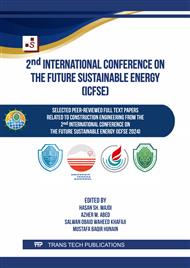[1]
P. Richard and M. Cheyrezy, "Composition of reactive powder concretes," Cem. Concr Res., vol. 25, no. 7, p.1501–1511, 1995.
DOI: 10.1016/0008-8846(95)00144-2
Google Scholar
[2]
M Canbaz, "The effect of high temperature on reactive powder concrete," Constr. Build. Mater, vol. 70, p.508–513, 2014.
DOI: 10.1016/j.conbuildmat.2014.07.097
Google Scholar
[3]
A. Abubakar, A. Mohammed, S. Duna, and U. S. Yusuf, "Relation-ship between Compressive, Flexural and Split Tensile Strengths of Waste Copper Wire Fiber Reinforced Concrete," Path Sci., vol. 8, no. 5, p.4001–4009, 2022.
DOI: 10.22178/pos.81-5
Google Scholar
[4]
F. Pita and A. Castilho, "Separation of copper from electric cable waste based on mineral processing methods: A case study," Minerals, vol. 8, no. 11, p.1–12, 2018.
DOI: 10.3390/min8110517
Google Scholar
[5]
B. Sulaiman, I. Bali, and W. Kushartomo, "Mechanical behavior of reactive powder concrete with glass powder substitute," 2015.
DOI: 10.1016/j.proeng.2015.11.082
Google Scholar
[6]
A. R. Kurup and K. S. Kumar, "Novel Fibrous Concrete Mixture Made from Recycled PVC Fibers from Electronic Waste," J. Hazardous, Toxic, Radioact. Waste, vol. 21, no. 2, p.1–7, 2017.
DOI: 10.1061/(asce)hz.2153-5515.0000338
Google Scholar
[7]
Z. Ali Hussain and N. Aljalawi, "Effect of Sustainable Glass Powder on the Properties of Reactive Powder Concrete with Polypropylene Fibers," Eng. Technol. Appl. Sci. Res., vol. 12, no. 2, p.8388–8392, 2022.
DOI: 10.48084/etasr.4750
Google Scholar
[8]
A. N. Abdullah and N. Aljalawi., "The Effect of Using Different Aspect Ratios of Sustainable Copper Fiber on Some Mechanical Properties of High-Strength Green Concrete," J. Eng., 2023.
DOI: 10.31026/j.eng.2023.11.10
Google Scholar
[9]
wafaa and S. S. H. Sami, "Influence of Waste Concrete and Glass Recycled on the Strength Properties of Green Reactive Powder Concrete," J. Eng., 2022.
DOI: 10.31026/j.eng.2022.12.04
Google Scholar
[10]
A. M. Najeeb and N. M. Fawzi, "Effect of Distributing Steel Fibers on Some Properties of Slurry Infiltrated Fiber Concrete," J. Eng., vol. 28, no. 4, p.64–76, 2022.
DOI: 10.31026/j.eng.2022.04.05
Google Scholar
[11]
Iraqi Standard No. 5: Portland Cement. Baghdad, Iraq: Central Organizationfor Standardization and Quality Control, 2019.
Google Scholar
[12]
IQS, "Iraqi Standard Specification No.45, Aggregate from Natural Sources for Concrete, Central Agency for Standardization and Quality Control, Baghdad, Iraq, 1984." p.17, 1984.
Google Scholar
[13]
"Iraqi Specification No .1703: Water Used for Concrete and Mortar. Baghdad, Iraq: Central Organization for Standardization and Quality Control, 1992.".
Google Scholar
[14]
ASTM C 1240-15, "Standard Specification for Silica Fume Used in Cementitious Mixtures, West Conshohocken," Pa, p.1–7, 2015.
Google Scholar
[15]
ASTM C494, "ASTM C494/C494M, 'Standard Specification for Chemical Admixtures for Concrete,' Annual book of ASTM standards ,2019.," ASTM Int., vol. 04, p.1–9, 2019.
DOI: 10.14359/51684228
Google Scholar
[16]
ASTM C 311-04, "Standard Test Methods for Sampling and Testing Fly Ash or Natural Pozzolans for Use in Portland-Cement Concrete.," Annu. B. ASTM Stand., vol. 04.02, p.204–212, 2005.
DOI: 10.1520/C0311
Google Scholar
[17]
ASTM-C 618-15, "Standard Specification for Coal Fly Ash and Raw or Calcined Natural Pozzolan for Use as a Mineral Admixture in Concrete (ASTM C618-15)," ASTM Int., p.1–4, 2015.
DOI: 10.1520/c0618-00
Google Scholar
[18]
X. Meng, L. Yan, J. Xu, F. He, H. Yu, and M. Zhang, "Effect of porosity and pore density of copper foam on thermal performance of the paraffin-copper foam composite Phase-Change Material," Case Stud. Therm. Eng., vol. 22, no. July, p.100742, 2020.
DOI: 10.1016/j.csite.2020.100742
Google Scholar
[19]
A. Sofi and G. Naidu Gopu, "Influence of steel fibre, electrical waste copper wire fibre and electrical waste glass fibre on mechanical properties of concrete," IOP Conf. Ser. Mater. Sci. Eng., vol. 513, no. 1, 2019.
DOI: 10.1088/1757-899X/513/1/012023
Google Scholar
[20]
ASTM 684, "Standard Test Method for Making, Accelerated Curing, and Testing Concrete Compression Test Specimens,C 684 – 99," ASTM Int., vol. 04, no. Reapproved, p.1–10, 1999.
DOI: 10.1520/c0684-99
Google Scholar
[21]
ASTM C109/C109M-99, "ASTM Standards C109/C109M − 16a," Stand. Test Method Compressive Strength Hydraul. Cem. Mortars (Using 2-in. or [50-mm] Cube Specimens), 2002.
DOI: 10.1520/c0109_c0109m-20
Google Scholar
[22]
ASTM C923/C293M, "Standard Test Method for Flexural Strength of Concrete (Using Simple Beam With Center-Point Loading)," ASTM Int., 2019.
DOI: 10.1520/c0293_c0293m-16
Google Scholar
[23]
B. A. Demiss, W. O. Oyawa, and S. M. Shitote, "Mechanical and microstructural properties of recycled reactive powder concrete containing waste glass powder and fly ash at standard curing," Cogent Eng., vol. 5, no. 1, 2018.
DOI: 10.1080/23311916.2018.1464877
Google Scholar
[24]
K. Kovler and N. Roussel, "Properties of fresh and hardened concrete," Cem. Concr. Res, vol. 41, p.775–792, 2011.
DOI: 10.1016/j.cemconres.2011.03.009
Google Scholar
[25]
M. C. G. Juenger and R. Siddique, "Recent advances in understanding the role of supplementary cementitious materials in concrete," Cem. Concr. Res., vol. 78, p.71–80, 2015.
DOI: 10.1016/j.cemconres.2015.03.018
Google Scholar
[26]
T. Oey, A. Kumar, J. W. Bullard, N. Neithalath, and G. Sant, "The filler effect: The influence of filler content and surface area on cementitious reaction rates," J. Am. Ceram. Soc., vol. 96, no. 6, p.1978–1990, 2013.
DOI: 10.1111/jace.12264
Google Scholar



